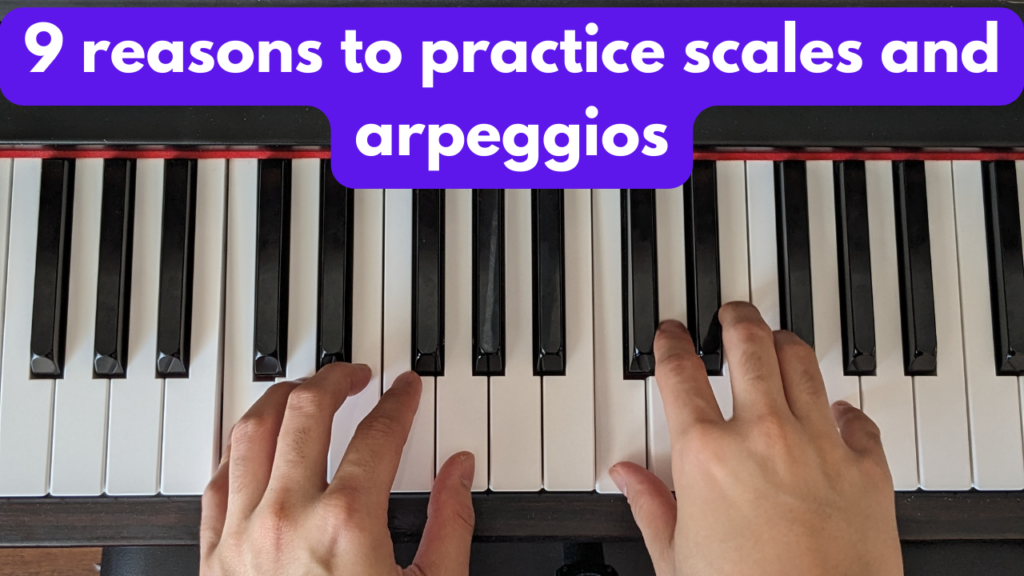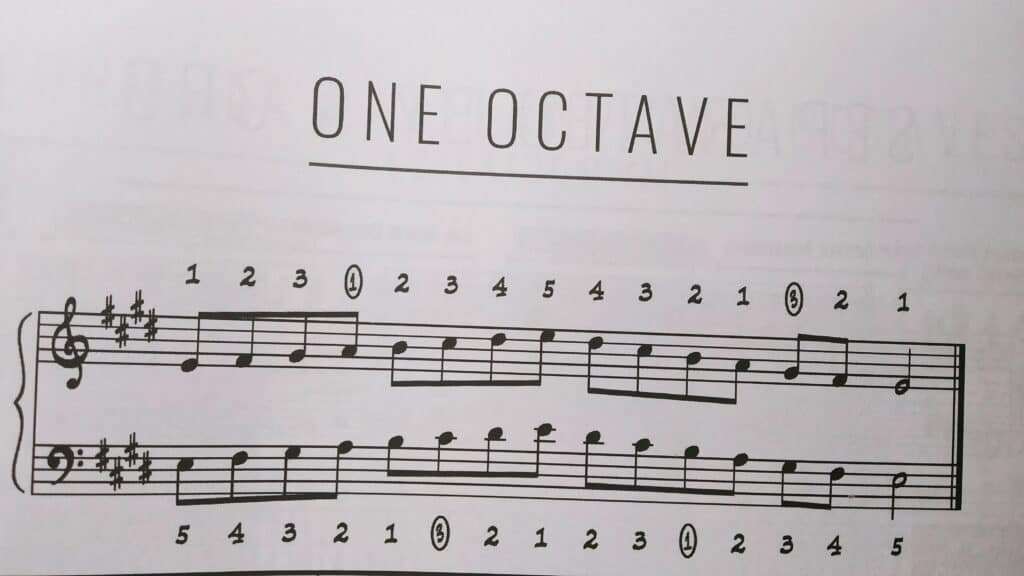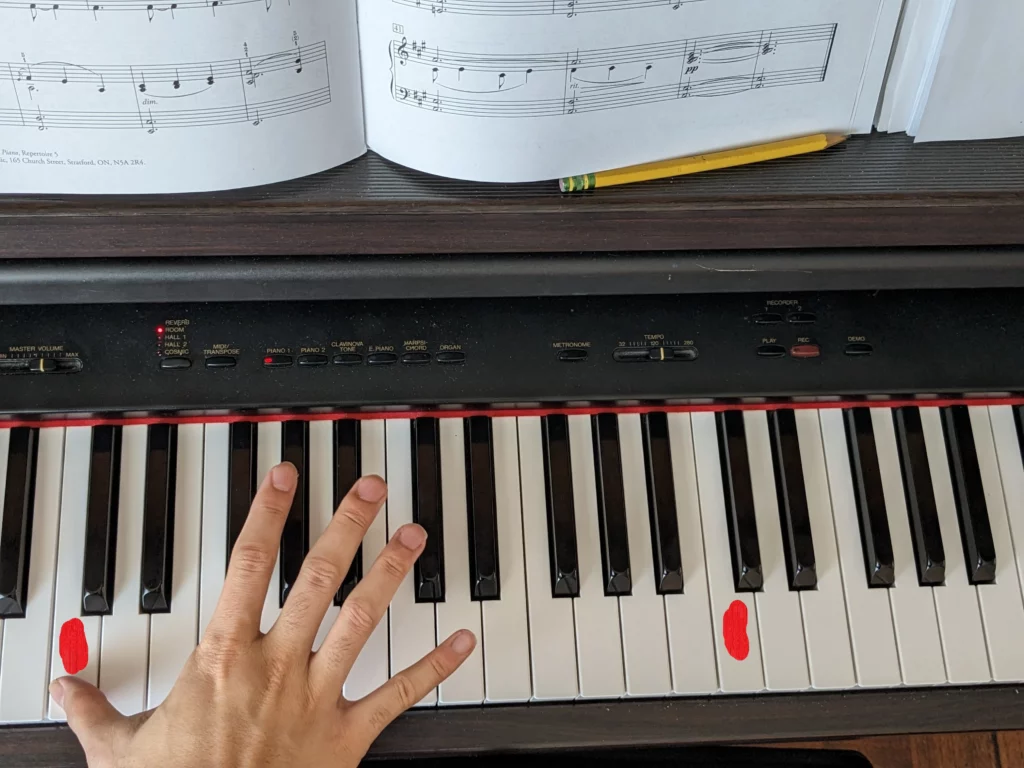This post contains affiliate links.
As a piano player, you always hear people telling you to practice scales and arpeggios, be it your teacher or from forums online. But have you ever asked yourself why you must practice your scales and arpeggios?

Here are 7 reasons to practice scales and arpeggios:
- Build speed and accuracy
- Build finger strength
- Improve your timing/rhythm
- Make learning new piano pieces easier
- Improve your sight-reading
- Help with learning jazz
- Great for warming up
- Take music exams like RCM or ABRSM
- Improve at playing with both hands
Read on to see more explanations for each point. I’ll also explain what scales and arpeggios are for anyone that doesn’t know. And at the end of the article, I’ll provide some tips for learning scales and arpeggios that I picked up along the way.
What are scales and arpeggios?
A scale is a set of successive notes following a pattern that you play on the piano. Scales start and end on the same letters. The key signature will tell you which notes to sharpen or flatten in the scale.
For example, take the scale of E Major. The E Major scale has 4 sharps F#, C#, G# and D#. These 4 sharps are present in the key signature. You’ll start with an E and play every note up to the next E, so what you play is E F# G# A B C# D# E.


On the other hand, the tonic arpeggio consists of 4 notes from its respective scale: the root (1st), the 3rd, the 5th and the root again. Arpeggios are played one note at a time. Taking the example of E Major, its arpeggio is E G# B E.


Why do piano players practice scales and arpeggio?
1. Build speed and accuracy
If you keep pressing the wrong keys when playing your piece, practicing scales and arpeggios can help improve your accuracy.
When you practice scales, especially arpeggios, you build spatial awareness of the keys on the keyboard, memorizing the positions and distances between the keys.
This will help you know where you are on the keyboard at all times, even if you’re not looking at the keyboard and your hands, and ensure that you’re consistently hitting the middle of the keys, not the edges!
An example of the usefulness of knowing the position of the keys inside out is for long octave jumps, where you play one note, then play that same note but a few octaves up.

If you still find yourself missing notes even after practicing scales and arpeggios, check out this article I wrote, where I share a few more tips for improving your accuracy.
Once you can play your scales and arpeggios accurately without tripping your fingers, it’s time to turn up the tempo to improve your speed.
If you’ve ever watched a piano performance and wondered how a pianist’s hands could be everywhere on the piano all at once, the answer starts with learning to practice scales and arpeggios at a high tempo.
But know that accuracy is always more important than speed. Playing a scale or arpeggio quickly doesn’t matter if you mess up the notes.
2. Build finger strength and flexibility
Practice scales and arpeggios to build strength in your fingers, especially the weak pinky fingers that can’t play as loud as the other.
Practicing scales and arpeggios will also make your fingers more flexible and better prepare you for pieces with difficult and awkward fingerings.
3. Improve your timing/rhythm
Being able to time when to play the notes on the sheet is important for playing evenly. If you don’t play notes evenly, the sound will be off, and the audience will notice immediately.
For example, if you play the same C note 4 times, with each C note having the same time value as an eighth note, and you accidentally hold one C note a bit longer than the others, you’ll immediately realize that the sound is off and that you aren’t playing evenly. It’s very noticeable.
So by practicing scales, where you are playing successive notes evenly, you can improve your timing and rhythm.
Take me, for example. At first, I had a tough time playing the 16th notes evenly. I was having trouble playing four notes in one beat evenly. But after hearing my teacher’s suggestion, I started practicing some scales and arpeggios and succeeded at playing them more evenly.
4. Make learning new piano pieces easy
You would be surprised at how often scales and arpeggios appear in piano pieces. By practicing scales and arpeggios, you’ll be able to recognize them in piano pieces instead of seeing the notes as is.
This means instead of reading the sheet, trying the learn the piece note by note, you’ll be able to say: “Oh, that’s the scale of F minor,” or “Ah, that’s the A Major tonic arpeggio.”
By recognizing scales and arpeggios, you’ll be able to learn that new piece in no time!
And even if it’s not the scales or arpeggios you know, the skill gained from hours of practice still applies and will quicken the learning process. You’ll also fumble less.
5. Improve your sight reading
Sight-reading is an important skill that any pianist should have. Although you may think practicing and memorizing a piece is good enough, let’s say at a party, you’ve already played all the details you learned, and someone suddenly requests a song you aren’t familiar with. What would you do?
As mentioned above, you’ll memorize the scales and arpeggios you learnt by practicing them. This will help you quickly identify and play any familiar scales or arpeggios you see in the song instead of struggling to read note by note.
6. Help with learning jazz
If you’re interested in learning jazz, know that jazz is built upon scales, chords and arpeggios. By practicing your scales and arpeggios, you’ll at least create a strong foundation in preparation for when you decide to dabble in jazz.
Knowing your scales and arpeggios well will also improve your improvisation, arguably the most important aspect of jazz.

7. Great warm-up exercise
Practicing your scales and arpeggios for 5-10 minutes before playing your piece is a great way to warm up your fingers, getting them all handy and fired up. Nothing is worse than playing the piano with stiff fingers!
Practicing scales and arpeggios are great if you’re nervous right before a performance or recital since it distracts and calms you down. It’s also great for warming up your hands if you plan to play outside where the weather is cold, and your hands are freezing.
8. To prepare for music exams
The RCM (Royal Conservatory of Music) exams are well-known and prestigious in North America. Its equivalent in the UK is ABRSM (Associated Board of the Royal Schools of Music). Many piano teachers have their students take these exams because they train students to become well-rounded pianists thanks to their high standards.
While you don’t need to take RCM/ABRSM exams to become great at playing the piano, I find that the levels systems of these exams set clear and attainable goals for me to work towards. Once I pass a level, I have a rough idea of my skill level and what pieces I’m able to play at that level.
So if you’re looking into taking these exams, know that you need to play scales and arpeggios alongside piano pieces in front of examiners during the exams. The scales and arpeggios you need to play are based on the level you’re doing. By learning scales and arpeggios now, you’re setting yourself up for success in the exam room.
9. Improve at playing with both hands
If you’re struggling with playing with both hands, practicing scales and arpeggios can help.
It’s easy to go up and down a scale or arpeggio with either your left or right hand. However, playing it with both hands simultaneously is significantly harder because you have to coordinate your hands to play at the same time.
After learning the benefits of learning piano scales, you may also want to know how long it takes to learn all Major and minor scales out there. Check out How Long Does it Take to Learn Piano Scales?
Some tips for learning scales and arpeggios
1. Use a metronome
A metronome is a tool that every musician must own. It’s like how a mechanic can’t work without a hammer.
You’ll find playing scales and arpeggios evenly much easier with a metronome. Simply play along to the beats of the metronome. It’ll also improve your rhythm.
2. Practice slow
When practicing scales and arpeggios, accuracy is always more important than speed. Being able to play a scale or arpeggio quickly doesn’t matter if you can’t play it right.
So when you learn a new scale or arpeggio, start with a slow tempo like 60. Once you can play it comfortably without stiffening your fingers, raise the tempo bit by bit. I recommend raising the tempo by 5 each time.
And if you find that you still mess up even at a slow tempo, go even slower. Go as slowly as possible until you can play the scale or arpeggio right.
3. Start with the C Major Scale
If you are a beginner and don’t know which scale and arpeggio to learn first, then learn the C Major scale and its arpeggio. It’s the easiest scale to remember because it has no sharps or flats, meaning it only has white keys.
However, don’t think just because we learn the C Major scale first means that it’s easy. Surprisingly, even long-time piano players have trouble with it! Check out the reasons why is this article Why is C Major the Easiest and Hardest Scale to Learn?

Once you finish learning the C Major scale and arpeggio, check out this article to know which scales and arpeggios to learn next.
4. Practice variations of scales and arpeggios
Practice the same scales and arpeggios over and over gets boring fast. That’s why you should also practice their variations to keep things interesting.
An example of a scale’s variation is the formula pattern, where both hands go up the scale for one octave and then split: your right hand goes up the next octave while your left hand goes down. Here’s an example of the C Major formula pattern:
For arpeggios, instead of starting the arpeggio at its root position, jump on its 3rd or 5th notes. These are called inversions. Take the example of the E Major arpeggio. Instead of E G# B E, practice its inversion G# B E G# or B E G# B.
For more variations and other things to practice, look for books like this one on Amazon. It includes every type of technical exercise for all major and minor scales. It even includes what fingerings you should use when playing scales and arpeggios.
5. Make a habit of practicing
Let’s be honest; practicing scales and arpeggios is dull for many people. I recommend practicing your scales and arpeggios for the first 5-10 minutes of your practice session. Doing this will quickly get them out of your way and warm up your fingers.
Remember to practice your scales and arpeggios; you will soon reap their benefits!

